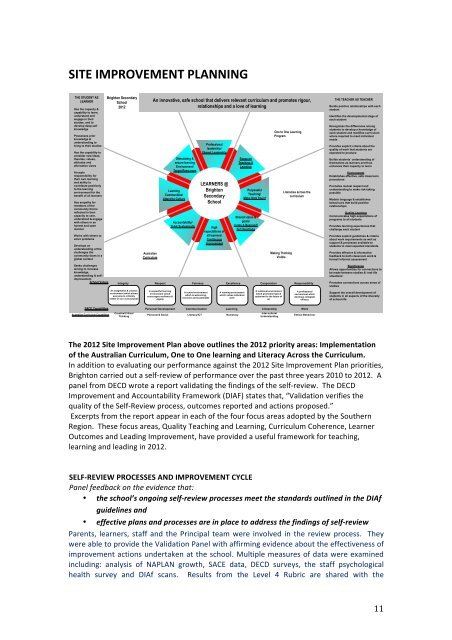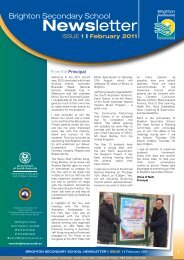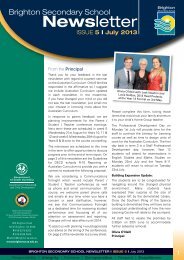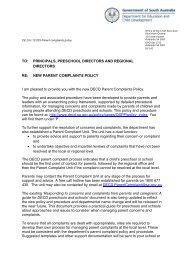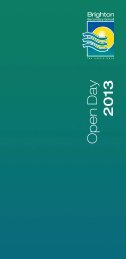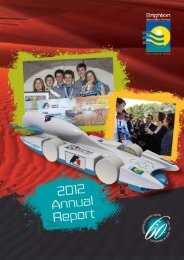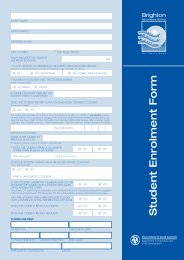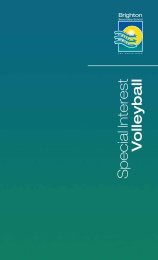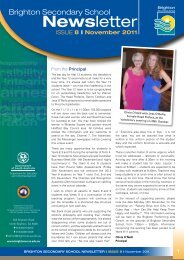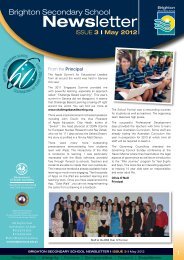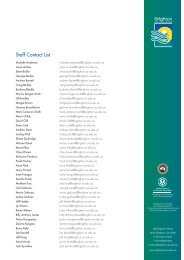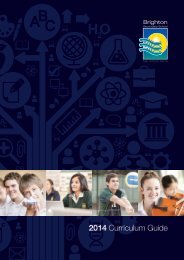2012 Annual Report - Brighton Secondary School
2012 Annual Report - Brighton Secondary School
2012 Annual Report - Brighton Secondary School
You also want an ePaper? Increase the reach of your titles
YUMPU automatically turns print PDFs into web optimized ePapers that Google loves.
SITE IMPROVEMENT PLANNING THE STUDENT ASLEARNERHas the capacity &capability to learn,understand andengage in theirstudies, and todevelop deep selfknowledgePossesses priorknowledge &understanding tobring to their studiesHas the capability toconsider new ideas,theories, values,attitudes andalternative viewsAcceptsresponsibility fortheir own learningand ability tocontribute positivelyto the learningenvironment for thebenefit of all learnersHas empathy formembers of thecommunity that isreflected in theircapacity to care,understand & engagewith others in anhonest and openmannerWorks with others tosolve problemsDevelops anunderstanding of thechallenges thecommunity faces in aglobal context<strong>Brighton</strong> <strong>Secondary</strong><strong>School</strong><strong>2012</strong>AustralianCurriculumAn innovative, safe school that delivers relevant curriculum and promotes rigour,relationships and a love of learningStimulating &secure learningEnvironment/Target ResourcesLearningCommunities/Attend to CultureAccountability/Think SystemicallyProfessionalleadership/Shared LeadershipLEARNERS @<strong>Brighton</strong><strong>Secondary</strong><strong>School</strong>Highexpectations ofall learners/ContinuousImprovementFocus onTeaching &LearningPurposefulTeaching/Make Data CountShared vision &goals/Listen & Respond/Set DirectionsOne to One LearningProgramMaking ThinkingVisibleLiteracies across thecurriculumTHE TEACHER AS TEACHERBuilds positive relationships with eachstudentIdentifies the developmental stage ofeach studentRecognizes the differences amongstudents to develop a knowledge ofeach student and modifies curriculumwhere required to meet individualneedsProvides explicit criteria about thequality of work that students areexpected to produceBuilds students’ understanding ofthemselves as learners and thusenhances their capacity to learnEnvironmentEstablishes effective, safe classroomproceduresPromotes mutual respect andunderstanding to make risk-takingpossibleModels language & establishesbehaviours that build positiverelationshipsQuality LearningCommunicates high expectations ofprograms to all studentsProvides learning experiences thatchallenge each studentProvides explicit guidelines & criteriaabout work requirements as well assupport & processes available tostudents to meet expected standardsProvides effective & informativefeedback to both classroom work &formal/ informal assessmentSeeks challengesaiming to increaseknowledge,understanding & selfimprovement<strong>School</strong> ValuesIntegrityRespectFairness Excellence Cooperation ResponsibilitySignificanceAllows opportunities for connections tobe made between studies & ‘real-lifesituations’Promotes connections across areas ofstudiesAn imaginative & creativeenvironment which allowseveryone to criticallyreflect on our core purposeA respectful learningenvironment whichencourages resilience &dignityA school environmentwhich is welcoming,inclusive and sustainableA learning environmentwhich values individualworkA relational environmentwhich promotes hope &optimism for the future ofallA professionalenvironment whichdevelops collegiateefficacySupport the overall development ofstudents in all aspects of the diversityof school lifeSACE CapabilitiesPersonal Development Communication Learning Citizenship WorkCreative/CriticalInter-culturalAustralian Curriculum Capabilities Personal & Social Literacy/ICT NumeracyEthical BehaviourThinkingUnderstandingThe <strong>2012</strong> Site Improvement Plan above outlines the <strong>2012</strong> priority areas: Implementation of the Australian Curriculum, One to One learning and Literacy Across the Curriculum. In addition to evaluating our performance against the <strong>2012</strong> Site Improvement Plan priorities, <strong>Brighton</strong> carried out a self-‐review of performance over the past three years 2010 to <strong>2012</strong>. A panel from DECD wrote a report validating the findings of the self-‐review. The DECD Improvement and Accountability Framework (DIAF) states that, “Validation verifies the quality of the Self-‐Review process, outcomes reported and actions proposed.” Excerpts from the report appear in each of the four focus areas adopted by the Southern Region. These focus areas, Quality Teaching and Learning, Curriculum Coherence, Learner Outcomes and Leading Improvement, have provided a useful framework for teaching, learning and leading in <strong>2012</strong>. SELF-‐REVIEW PROCESSES AND IMPROVEMENT CYCLE Panel feedback on the evidence that: • the school’s ongoing self-‐review processes meet the standards outlined in the DIAf guidelines and • effective plans and processes are in place to address the findings of self-‐review Parents, learners, staff and the Principal team were involved in the review process. They were able to provide the Validation Panel with affirming evidence about the effectiveness of improvement actions undertaken at the school. Multiple measures of data were examined including: analysis of NAPLAN growth, SACE data, DECD surveys, the staff psychological health survey and DIAf scans. Results from the Level 4 Rubric are shared with the 11


